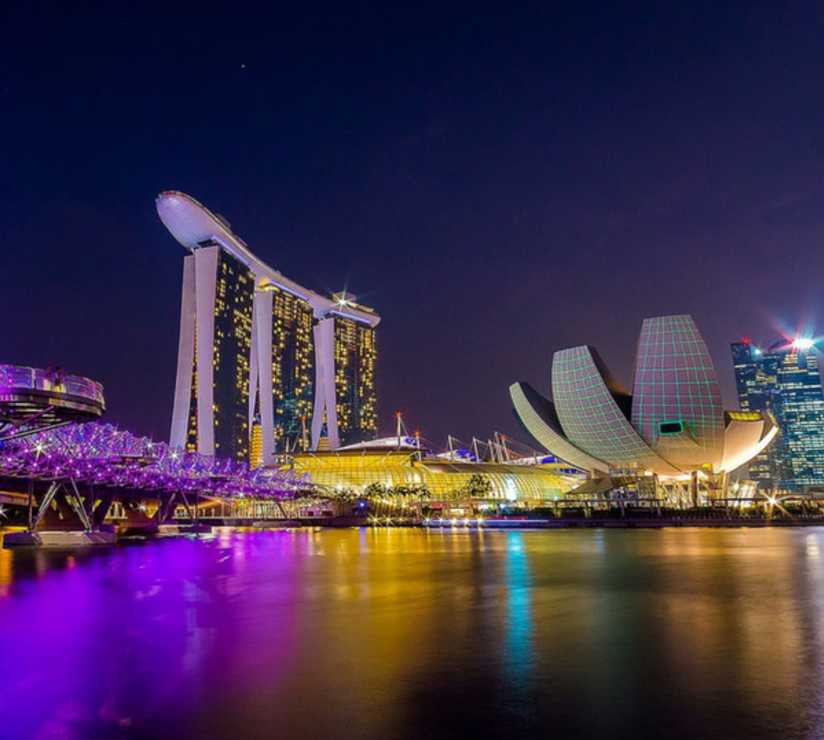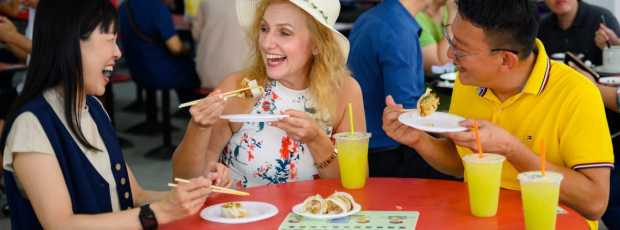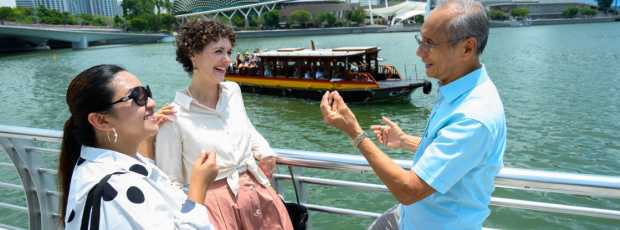Table Of Contents
- Where Southeast Asia Feels Like the Future
- Reasons to Visit Singapore: Because You Can Eat Through a Nation
- The MRT Isn't Just Efficient: It's Empowering
- Singapore's Green Side Isn't Just Parks
- There's Something to Do at Every Hour
- Cultural Diversity Isn't a Slogan
- Even the Malls Surprise You
- Visit Because No One Leaves Hungry
- Singapore Is Small But Never Limited
- Plan Less, Taste More
I've lived in Singapore my entire life, and I still get that little thrill when the plane descends over Marina Bay.
The city spreads out below like a circuit board made of lights and green spaces. It's nothing like the chaotic beauty of Bangkok or the colonial grandeur of Ho Chi Minh City.
![Sentosa Island]()
Singapore feels different. It feels like someone took the best parts of other Southeast Asian cities and built them into the future.
When people ask me for reasons to visit Singapore, I tell them to forget everything they think they know about tropical cities. This place rewrites the rules.
Where Southeast Asia Feels Like the Future
Most cities in this region wear their history like layers of paint. You can see decades of growth in every street corner.
Singapore does this too, but not quite the same way. It builds forward while keeping its soul intact.
The Marina Bay Sands infinity pool catches the sunset every evening at 7 PM. Below, Gardens by the Bay hums with that quiet efficiency that makes Singapore work.
The Supertrees aren't just Instagram props. They collect rainwater and generate solar power.
![Gardens by the Bay light show at night.]()
This isn't futuristic architecture for show. It's practical magic.
Singapore took the tropical climate and made it work for the city. The buildings breathe. The gardens clean the air. The public spaces invite you to linger.
Futuristic Architecture That Actually Works
I like to bring visiting friends to the Marina Bay waterfront at sunset. They always ask the same question: "How is this place real?"
Singapore answers that question every day. It's real because it was planned to be livable.
![Marina Bay skyline from a rooftop bar. ]()
The city state approach means every square meter matters. Nothing gets wasted.
Every public space serves multiple purposes. Every building considers the people who will use it.
Marina Bay Sands isn't just a hotel with a famous infinity pool. It's an integrated resort that includes shopping, dining, entertainment, and business facilities.
The design channels wind through the building to cool the public spaces naturally.
The ArtScience Museum next door looks like a lotus flower blooming from the bay. Inside, permanent galleries house traveling exhibitions that rotate quarterly.
The building collects rainwater through its petals and channels it into the marina.
Reasons to Visit Singapore: Because You Can Eat Through a Nation
![Close-up of kopi and kaya toast at a kopitiam. ]()
My Saturday mornings start the same way they've started for many years.
Kopi at the neighborhood kopitiam. Kaya toast that's been made the same way since my grandmother's time.
Hainanese Chicken Rice: A National Obsession
Every Singaporean has opinions about Hainanese chicken rice. The rice must be fragrant with chicken fat and ginger.
The chicken should be silky and tender. The chili sauce needs just the right balance of heat and garlic.
![Colorful plates at Maxwell Food Centre. ]()
Tian Tian Hainanese Chicken Rice at Maxwell Food Centre draws lines of locals and tourists. The wait is worth it. The chicken skin glistens.
The rice grains separate perfectly. The soup arrives steaming hot with winter melon and cabbage.
Hawker Centers: Democracy in Action
The hawker centers aren't just about food. They're about community.
The coffee shop uncle knows your order. The satay man saves you the best skewers. The dessert lady always gives you extra ice cream.
![Close-up of hainanese chicken rice.]()
Street food here isn't street food. It's national cuisine served in public dining rooms. The government built these spaces for everyone.
Ministers eat next to construction workers. Tourists share tables with taxi drivers.
Cultural diversity isn't a marketing slogan when you're eating laksa made by a Peranakan family recipe.
Or when the Indian rojak vendor teaches you the proper way to eat his creation. Or when the Malay satay master explains why his peanut sauce tastes different from everyone else's.
Looking for a private city experience in Singapore?
Explore the city with a local who plans a private day just for you; no groups, no scripts.
The MRT Isn't Just Efficient: It's Empowering
![Inside a clean MRT station. ]()
The train arrives every two minutes during peak hours. The air conditioning works. The announcements are clear in the country's four official languages.
Public transport in Singapore isn't just about moving people. It's about dignity. The elderly get priority seats that people actually give up.
The disabled have accessible platforms at every station. The system works because everyone makes it work.
Changi Airport: Your First Singapore Experience
Changi Airport connects to the city center in forty minutes. No traffic jams. No haggling with taxi drivers. No stress about timing. The MRT runs until midnight and starts again at 5 AM.
![Transit map on train wall.]()
Changi Airport itself deserves a full day. Terminal 3 houses the butterfly garden with over 1,000 tropical butterflies.
Terminal 4 features heritage zones that tell Singapore's immigration story.
Jewel Changi brings indoor forests and waterfalls to air travel.
![Visitors arriving at Singapore Changi airport.]()
This changes how you experience the city. You can live in the east and work in the west. You can shop on Orchard Road and eat in Chinatown. You can catch a sunset at Marina Bay and still make it home for dinner.
The public transport system makes Singapore accessible to everyone. Budget travelers use the same trains as business executives. Everyone gets to the same places at the same time.
Singapore's Green Side Isn't Just Parks
The Bukit Timah Nature Reserve sits in the middle of the island. Primary rainforest grows ten minutes from the city center. I've seen wild monkeys there. Monitor lizards cross the trails. Hornbills nest in the canopy.
Bukit Timah Nature Reserve: Wild Singapore
This Nature Reserve protects Singapore's highest point at 163 meters above sea level. The summit trail takes forty minutes to climb through dense jungle.
Long-tailed macaques swing through the trees. Flying lemurs glide between branches after dark.
![Rainforest path. ]()
The reserve preserves more plant species than the entire North American continent. Dipterocarp trees tower 60 meters high. Wild ginger flowers bloom along the streams. Strangler figs wrap around host trees like natural sculptures.
Singapore Botanic Gardens earned UNESCO World Heritage Site status for good reason. The orchid collection spans three centuries. The rainforest section preserves original jungle. The lakes reflect century-old trees.
Nature lovers find surprises throughout the city. Sungei Buloh Wetland Reserve protects migratory birds and mudflat ecosystems. The mangrove boardwalks wind through habitats that existed before the city.
![Boardwalk through Sungei Buloh.]()
The Cloud Forest at Gardens by the Bay recreates a mountain ecosystem inside a dome. Real mist. Real plants. Real waterfalls. The Flower Dome houses Mediterranean plants in tropical Singapore.
This isn't accidental green space. Singapore calls itself a Garden City because it planned to be one. Every development includes parks.
Every neighborhood has trees. Every new building adds more green than it removes.
Park connectors link green spaces across the island. You can cycle from East Coast Park to Jurong without touching a road. The network spans over 300 kilometers of dedicated paths.
There's Something to Do at Every Hour
Universal Studios Singapore opens at 10 AM. The rides work. The lines move. The staff speaks your language. Sentosa Island surrounds the theme park with beaches, golf courses, and resort hotels.
![Fireworks over Sentosa beach.]()
The Singapore Zoo and Night Safari change how you think about animal parks. No cages. No concrete barriers. Animals live in spaces designed for their comfort, not just visitor viewing.
Singapore Zoo pioneered the open concept in tropical settings. White rhinos graze in paddocks separated by hidden moats. Orangutans swing on islands surrounded by water. Elephants bathe in pools deep enough for swimming.
Clarke Quay comes alive after dark. The riverside restaurants serve everything from Chinese hot pot to Italian pasta. The bars stay open until 3 AM. The music spills onto the street.
![Clarke Quay nightlife scene.]()
Major cities compete on nightlife or daytime attractions. Singapore delivers both. You can spend the morning hiking in Bukit Timah, the afternoon shopping on Orchard Road, and the evening eating at a more relaxed restaurant.
What if your day in Singapore was planned by someone who knows it — and you?
City Unscripted matches you with a local host who creates a private experience based on your interests, not a set route.
Cultural Diversity Isn't a Slogan
When you visit Singapore, you have to stop at Little India. It smells like curry leaves and jasmine flowers. The shops sell silk saris and gold jewelry.
Tamil music plays from every storefront. The Sri Veeramakaliamman Temple draws devotees and tourists alike.
![Street mural in Little India.]()
Kampong Glam: Where History Lives
Kampong Glam centers around the golden dome of Masjid Sultan. Haji Lane runs parallel to the mosque, lined with boutiques and cafes. Arab Street sells perfumes, carpets, and traditional clothing.
![Masjid Sultan in Kampong Glam. ]()
The Sultan Mosque dominates the skyline with its golden domes and towering minarets. Built in 1928, it accommodates 5,000 worshippers for Friday prayers.
The architecture blends Saracenic and Moorish influences with local tropical adaptations.
Haji Lane: Creative Heart
Haji Lane stretches barely 100 meters but packs personality into every shophouse. Here, vintage boutiques occupy ground floors. Rooftop bars hide on upper levels. Street art covers every available wall space.
The narrow lane transforms throughout the day. Morning brings coffee shops and breakfast crowds. Afternoon draws shoppers hunting for unique finds. Evening fills the bars with creative professionals and tourists.
The Buddha Tooth Relic Temple in Chinatown houses sacred artifacts and museum collections. The architecture follows traditional Tang Dynasty designs. The rooftop garden grows herbs used in Chinese medicine.
![Buddha Tooth Relic Temple.]()
Cultural Diversity in Practice
Deepavali brings oil lamps to every Hindu household. Chinese New Year decorates shopping centers with red lanterns.
Hari Raya features open houses where Muslim families welcome neighbors regardless of religion. Christmas lights go up in November despite the tropical setting.
The cultural diversity creates unexpected combinations. Chinese-Muslim food stalls serve halal versions of traditional dishes.
I like to say that Indian-Chinese cuisine exists nowhere else in the world. At least, not like this. Peranakan culture blends Chinese and Malay traditions into something entirely new.
Even the Malls Surprise You
![Orchard Road street-level photo.]()
Orchard Road stretches for two kilometers of shopping centers.
Even the shopping malls have personality. ION Orchard focuses on luxury brands. Takashimaya brings Japanese department store culture. Far East Plaza serves budget shoppers and local fashion.
The food courts in these malls serve hawker center quality at air-conditioned comfort. The basement of Takashimaya has better sushi than most restaurants.
The top floor of ION offers views over the city.
Luxury brands line Orchard Road from Tanglin to Somerset. Every international name has flagship stores here. Local designers showcase alongside global fashion houses. The shopping density rivals Fifth Avenue or Bond Street.
![Open-air atrium in Jewel Changi. ]()
Jewel Changi Airport redefined what airports can be, and it alone makes Singapore worth visiting. The indoor waterfall drops forty meters through the center. The butterfly garden houses tropical species.
The walking trails wind through indoor forests.
Shopping malls in Singapore integrate with public transport. You can shop, eat, and catch the train without going outside. The humid climate makes this practical, not lazy.
The malls also serve as community centers. Elderly residents practice tai chi in the corridors before shops open. Students study at open air food courts. Domestic workers gather on Sundays for socializing and remittances.
Visit Because No One Leaves Hungry
![Chili crab being served. ]()
Chili Crab: Singapore on a Plate
Chili crab defines Singapore cuisine. Sweet, spicy, messy, perfect. The best versions come from Newton Food Centre or Lau Pa Sat. Bring napkins.
Expect to get sauce on your shirt. Worth every bite.
The sauce combines tomato, chili, egg, and rice vinegar into something magical. Fresh mud crabs arrive live at the restaurant. The shells crack under wooden mallets. The meat pulls away in sweet chunks.
Eating chili crab requires technique. Use the shells as scoops for sauce. Suck the claws for maximum flavor. Order mantou bread for sopping.
Share with friends for the full Singapore experience.
Lau Pa Sat serves satay after dark. The smoke from dozens of grills fills the air. The peanut sauce recipes vary by stall. The meat stays tender and flavorful.
![Satay grilled over open flame at Lau Pa Sat.]()
Tip
We match you with the right host, not just any guide.Want to experience the real Singapore with someone who lives there?
A fully private experience, planned and led by a local host who tailors the day to you
Singapore Is Small But Never Limited
The entire island nation fits inside New York City. You can drive from east to west in forty minutes. Walk from north to south in six hours.
Take the MRT anywhere in ninety minutes.
![View from Pulau Ubin across to the skyline.]()
Small size creates unexpected benefits. Everything connects to everything else. You can live anywhere and access everything. Neighboring countries feel close enough for weekend trips.
The city state model means focused development. No suburban sprawl. No abandoned districts. Every area serves a purpose and gets maintained.
Singapore's Strategic Position
Singapore sits at the crossroads of Southeast Asia. Malaysia borders the north. Indonesia surrounds the south. Thailand, Vietnam, and the Philippines lie within easy flying distance.
This position makes Singapore the perfect base for exploring the region. Weekend trips to Kuala Lumpur take four hours by bus. Bali flights depart hourly. Bangkok connects in two hours. Ho Chi Minh City requires just ninety minutes of flying time.
![Bus leaving from Singapore to a neighboring country.]()
Regional airlines use Singapore as their hub. Budget carriers offer competitive prices. The connections make spontaneous travel possible. You can decide Friday to spend the weekend in Angkor Wat.
Merlion Park draws tourists for good reason. The symbol of Singapore sits where the Singapore River meets Marina Bay.
The skyline backdrop changes with new construction, but the park remains a constant.
![View of Merlion Park with tourists.]()
Tourist attractions in Singapore work efficiently. Lines move quickly. Information is clear. Staff speaks multiple languages. The experience matches the expectation.
The Infinity Pool Experience
The Marina Bay Sands infinity pool stretches 150 meters across the sky. Swimming here feels like floating above the city. The water temperature stays perfect year-round. The views change from sunrise to midnight.
Access requires a hotel room key, but the lobby bars offer similar vistas. Ce La Vie rooftop serves cocktails with identical views. The observation deck provides photo opportunities without accommodation costs.
Singapore reasons to visit go beyond the obvious ones. The city works because it was designed to work. The culture thrives because it gets supported. The food satisfies because it comes from real traditions.
For those seeking relaxing things to do in Singapore, the city offers peaceful gardens, gentle river cruises, and quiet temple courtyards.
Why Singapore Works
Singapore's success comes from intentional planning and consistent execution. The government prioritizes long-term thinking over short-term gains. Infrastructure projects consider decades of future growth. Social policies balance individual freedom with collective responsibility.
The education system produces multilingual citizens who can navigate global business cultures. The legal framework protects intellectual property while encouraging innovation.
The financial sector connects Asian markets with Western capital.
This creates opportunities for visitors too. English works everywhere. Credit cards are accepted universally. Transportation runs on time. Services meet international standards.
![Tourists enjoying their Singapore tour.]()
Plan Less, Taste More
I watch tourists stress about Singapore itineraries. They plan every hour. They book every restaurant. They research every attraction.
Singapore rewards spontaneity. The MRT connects everywhere quickly. Hawker centers always have empty tables. Parks stay open late. Museums offer evening hours.
The reasons to visit Singapore aren't complicated. Clean streets. Safe neighborhoods. Reliable transport. Great food. Comfortable weather. Friendly people.
Ready to plan your perfect day in Singapore?
Start your experienceWhat if your day in Singapore was planned by someone who knows it — and you?
City Unscripted matches you with a local host who creates a private experience based on your interests, not a set route.
Want to experience the real Singapore with someone who lives there?
A fully private experience, planned and led by a local host who tailors the day to you











